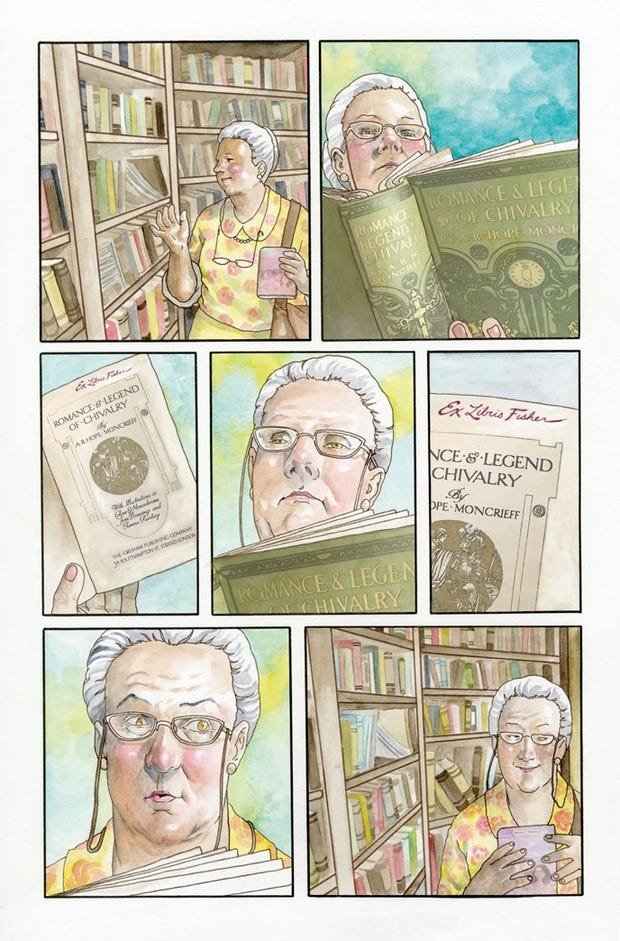Previous post on symbolism in Chivalry over here.
Neil Gaiman's Chivalry is a sweet and simple story on the surface, but is full of allusions and literary references, and the symbolism in the art, as well as the art style, serves as meta-narrative.
One of the pages readers ask about the most is this one, where Mrs. Whitaker in the Oxfam shop finds an old book entitled The Romance and Legend of Chivalry (1912).
Written by Scottish author A. R. Hope Moncrieff, this popular tome was published in multiple printings and editions in many languages. While most of his books were intended for young boys, they would be over the heads and/or not to the taste of many modern readers.
They are dense and wordy, but I love them.
You can find good copies of the first edition with the gorgeous cover you see here at reasonable prices. If you can spare $20-$30, you shouldn't have to settle for cheap, modern editions which are ugly and don't have that pretty gold stamping.
It should be obvious why Mrs. Whitaker has focused on this book during the course of Chivalry.
What some didn't understand is the reference there in the top corner written in red pen: "Ex Libris Fisher".
This translates to "From the Library of Fisher" as in The Fisher King.
The Fisher King otherwise known as King Pelles, Sir Galaad's grandfather. (Yes, Galaad is the same as Galahad, it’s not misspelled, more on that later).
The inset images in the illuminated manuscript sequences aren't just there to dress up the page. They have meaning.
On this page the meaning is pretty obvious: in the upper right, a fish, then an image of a man fishing, then young Galaad, then the castle. Also, King Pelles holds a spear.
King Pelles was known as The Fisher King because he had a disabling wound and was unable to do much of anything but sit in his boat and go fishing.
There are a number of layers of meaning to the tale of the Fisher King, the most obvious being that the king, also known as the Grail King, charged with the task of protecting the Holy Grail, is a fisher even as Christ is a fisher of men.
But the Fisher King, it is implied, has been wounded as punishment for a sin, the which sort of varies depending on the King Arthur tale version you read.
The Fisher King is a pun on the French word for sin.
Pelles was wounded in the thigh. Some interpret this as a wound to the genitalia, which robbed the king of his vitality. Since the strength of the king was the strength of the land, the land withered as well.
Referring directly to a man's wounded genitals was super-rude back in the day no matter what they do on Twitter now: so it was common to simply refer to a "wound in the thigh" if a man had issues in his nether regions.
The spear the king holds is the Spear of Longinus, which a Roman centurion used to pierce the side of Christ, and which was used to deliver a wound to Pelles, the Dolorous Stroke, a wound which cannot be healed until the coming of the Grail Knight who will ask the right questions and take the right actions.
These actions depend on which versions you read, and we could be here all day going over them and who did them.
As for the sin of Pelles, it is asserted that Pelles was either a philanderer or he refused to marry the woman he should have in order to ensure the bloodline of the Grail. To repair that damage, Pelles sets about getting his daughter Elaine going with Lancelot (by shocking means) to ensure that Galaad is born because he knows only Galaad can achieve the Grail.
In Sir Thomas Malory's Le Morte D'Arthur the story is rather confusing and the role of King Pelles gets split between Pelles and another king.
But there are a lot of wonky things in Malory, so don't stress, the man never had an editor, he was in jail while he wrote most of the book, and he did his best.
Pelles is healed by the Holy Blood on the spear. Or a knight asking the right questions. Or by drinking from the Grail.
Depending on who is telling the story.
With the Achievement of the Grail and the redemption of King Pelles by the knights, in particular his grandson Galaad/Galahad, the king is healed, sins are forgiven, and the land is healed.
Mrs. Whitaker, who is being visited by young Galaad on a quest, has just found a tome in an Oxfam shop that once belonged to Galaad's grandfather.
Pelles, who failed to be as chivalrous as he should have been and ended up spending a lot of time fishing instead of running his country, perhaps learned some lessons from The Romance and Legend of Chivalry that got passed down to Galaad, because this Neil Gaiman tale is Twilight Zone-ish like that.
And now you know.
Chivalry by Neil Gaiman, adaptation and art by me, illuminated manuscript lettering by me, lettering by Todd Klein, published by Dark Horse Comics. Ask for it at fine bookstores or order online.







Were you Arthurian in your youthful interests, Colleen?
Your watercolor are breathtaking, Colleen!!
Thank you for the history lesson, lots of delicious information in this Text^^